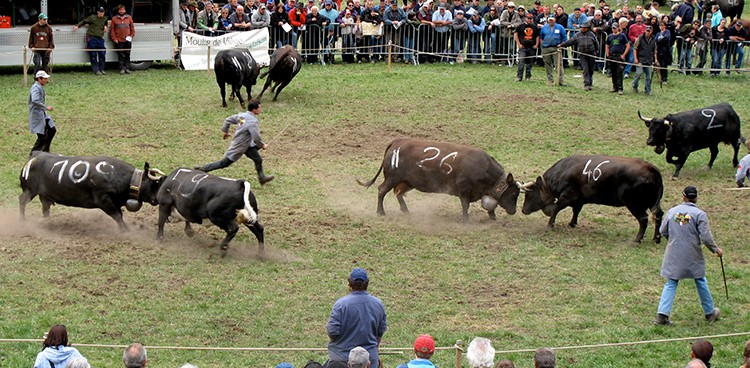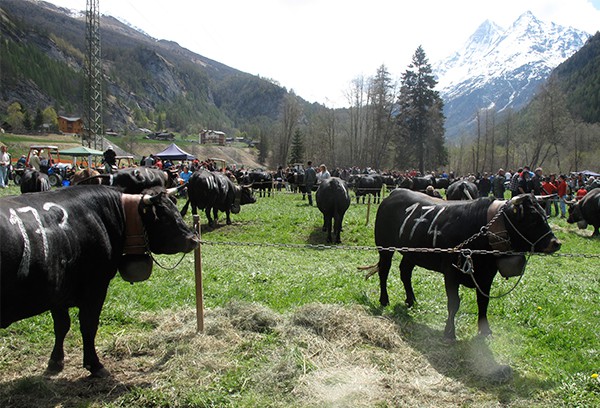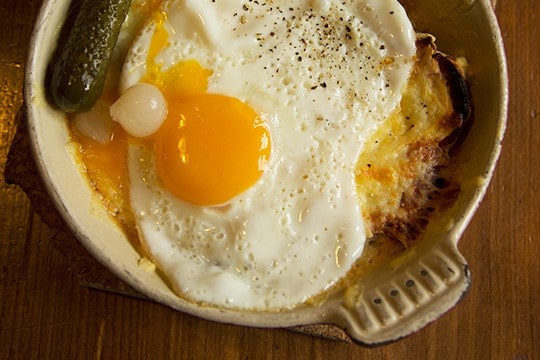
I thought the Swiss were a low-key group—politically neutral, lacking religious fervor, not terribly excited by celebrities or sports—that is, until I moved to the Va de Bagnes. There, in the steep valley squished between the border of Italy and France, I found something that really gets people jazzed: cows. And not just any cows—queen cows.
Known in French as reines, females of the dark, stocky Hérens breed instinctively organize themselves into a hierarchy. When brought to fresh pasture in spring, they butt heads to assert dominance, the winner scoring dibs on the most pristine patches. Humans have been looking on for generations, turning the natural phenomenon into a spectator sport. Cows face off several times each summer in the Val de Bagnes at Combats des Reines (Queen Fights), which draw thousands of attendees. I’d been working in a Swiss cheese cave all summer and the time had come to melt those cheeses into raclette alongside other valley cheesemakers at the big event’s food tent.
On the eve of that first combat, I pictured a scene straight out of Gladiator—I was scared. Would my compassion for animals override my cultural sensitivity? The thought wasn’t a stretch: Cow fights have garnered backlash from animal rights activists recently. Today they’e forbidden in Switzerland except for here, in the state of Valais, where matches are argued to be an integral part of local tradition.

Maybe it was all that Fendant wine, but I nearly shed a tear watching Christophe Cloître, proud owner of champion cow Tracy, rush into the ring (along with his entire family—and village) to embrace his winning queen. As it turns out, the local cows have it pretty good: They all have names, live on small farms, and spend summers outdoors in the mountains. And they should be treated well—they supply the precious milk used to make Fromage de Bagnes, the original raclette cheese.
If livestock fighting isn’t your scene, there’s always a tent nearby, like the one I worked at, where you can gorge on raclette dishes—including signature Croûte au Fromage (recipe below)—until the cows come home.

Croûte au Fromage
Ingredients
- 4 1- inch-thick slices French bread toasted
- ¼ cup white wine preferably Fendant or Chasselas
- 1 ½ cups grated Swiss cheese try a mix of raclette, fontina, and Vacherin Fribourgeois
- Freshly ground black pepper
- Cornichons to garnish
- Pickled pearl onions to garnish
- 2 slices baked ham optional
- 2 fried eggs optional
Instructions
- Heat oven to 425°F. Place toasted bread slices in 2 small casserole dishes. Sprinkle wine and cheese into dish, making sure to cover toasts and any empty space.
- Bake 5 to 7 minutes, until cheese is melted completely. Broil 1 additional minute or until cheese is golden brown and bubbling. Season with pepper and garnish with cornichons and pearl onions. Serve with a glass of white wine.
- OPTIONAL: For a croûte complète, add 1 slice of ham between the bread and cheese in each dish before baking; once cooked, top each with a fried egg.



